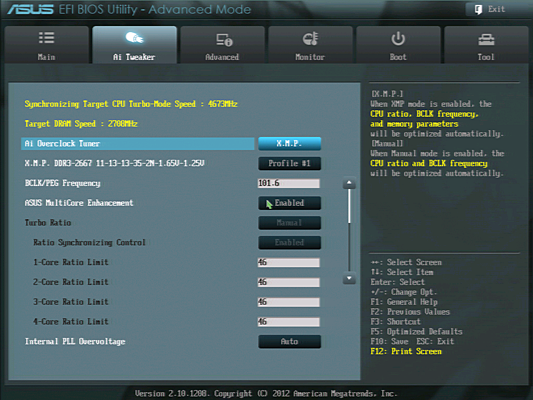Six $220-280 Z77 Express-Based Motherboards, Reviewed
Expanded graphics card support, enhanced on-board features that include Thunderbolt on some models, and more-robust voltage control are all good reasons to consider paying a little extra for a higher-end motherboard. Today we examine five top choices.
Sabertooth Z77 Firmware
Asus' AI Tweaker menu hasn’t changed much in the past few years, providing both fully-manual and XMP-based manual overclocking capabilities. The difference between those two options is that XMP starts the process with higher DRAM timings, voltage levels, and data rates.
Our combination of XMP and power controls also locked out CPU ratio selection from the main menu, though synchronized ratios can still be selected from the CPU Power Control submenu.
A 1.245 V CPU core setting got us an actual 1.25 V, providing CPU overclocking stability up to 4.67 GHz.
Manufacturers have been quietly pushing higher DRAM voltage, apparently in an effort to boost DRAM overclocking, but that really wasn’t necessary for the Sabertooth Z77. A 1.625 V setting produced 1.65 V at the DIMM slot in spite of the false 1.630 V firmware reading, and the board was able to push G.Skill’s DDR3-2666 to DDR3-2800 in spite of our compensation efforts.
Primary, secondary, and tertiary timings are all accessible for memory tuning.
Depending on other settings, the CPU ratio may be accessible only from the CPU Power Management submenu. Asus also provides over-current protection adjustments here, but told us that Auto is the best choice for all but the most extreme (high-voltage) overclocks.
The Sabertooth Z77’s Ultra High Load-Line Calibration setting is supposed to reduce voltage droop by 75%, but it actually caused our voltage to go up by a few millivolts at full load. The effectiveness of each load-line level varies with changes in baseline core voltage and overclock amount.
Get Tom's Hardware's best news and in-depth reviews, straight to your inbox.
Current page: Sabertooth Z77 Firmware
Prev Page Sabertooth Z77 Software Next Page ECS "Golden Board" Z77H2-AX-
roberta As u have reviewed SIX (6) motherboards, the article's title should be:Reply
"Six $220-280 Z77 Express-Based Motherboards, Reviewed" -
mayankleoboy1 No SATA and USB tests ? data transfer speed differences will typically be noticable in everyday usage.Reply
Also, the time taken to show the windows loading screen/ BIOS page.. -
admit it.Reply
you really liked the black/grey dimms and PCI slots of the gigabyte better than the blue/black of the MSI! -
Crashman robertaAs u have reviewed SIX (6) motherboards, the article's title should be:"Six $220-280 Z77 Express-Based Motherboards, Reviewed"Let's see what the article says:ReplyThe one motherboard in today’s line-up with a 48-lane PCIe 3.0 bridge is ECS’ Golden Z77H2-AX. Unfortunately, this platform climbed $40 beyond the budget limit of today’s round-up in the time we've been reviewing it. We're tired of seeing board vendors playing pricing games based on our review schedule (this isn't the first time we're seeing a curiously-timed price move). So, since we put the work in to review ECS' submission, we're including our already-gathered data and simply withholding the board from any award candidacy.
mayankleoboy1No SATA and USB tests ? data transfer speed differences will typically be noticable in everyday usage.Also, the time taken to show the windows loading screen/ BIOS page..Would have covered windows load time except that it wasn't markedly different. That is, after disabling empty SATA controllers. If you count the time that it takes to get the "No Device Found" error on boards that have extra SATA controllers, you're penalizing a board for having more features.
Andrew Ku tests drive controllers. I'm trying to get him to "write the book" on controller performance, since dozens of boards use only a few different controllers. As for testing things like Z77 controller performance on board A vs Z77 controller performance on board B, it's a waste of time unless something is broken. So the article looked for "broken stuff". See the red bar on the first chart:
http://www.tomshardware.com/reviews/z77x-up5-th-z77a-gd80-z77-oc-formula,3305-22.html
With nothing broken, there's no excuse to test the Z77 controller six times. Back to me begging Andrew Ku for a comprehensive comparison of every SATA controller currently available on mainstream-brand enthusiast boards.
-
JeanLuc Arghh! Why the hell are you overclocking the base clock on Z77!! That will most likely cause permanent damage to your CPU.Reply -
You left out a key aspect for overclockers which is vcore offset.Reply
This allows ocer's to achieve higher overclocks while still retaining the power saving functions, instead of being forced to either reduce the overclock, or be forced to run high voltage 24/7.
MSI doesn't have this key feature. -
Onus I would think that the Sabertooth's five year warranty merits at least a mention in any value conclusion.Reply
-
luciferano JeanLucArghh! Why the hell are you overclocking the base clock on Z77!! That will most likely cause permanent damage to your CPU.Reply
Overclocking the BLCK is very unlikely to cause any damage, it's just likely to not give much of a stable overclock. -
Crashman jtt283I would think that the Sabertooth's five year warranty merits at least a mention in any value conclusion.I actually missed that, having checked the lesser brands just to make sure those still had their three year warranty. Will add it.Reply








